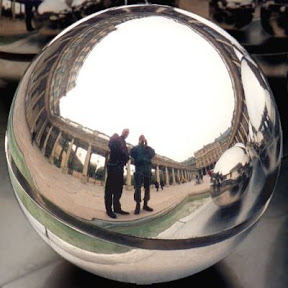 This weekend was London's annual "Open House" event, where hundreds of public, private and commercial buildings around the city are open to the public. We usually try to use this opportunity to see buildings we wouldn't normally have access to, and this year we decided to vist somewhere close to home - a major industrial building which dominates the view from one side of our flat in Deptford.
This weekend was London's annual "Open House" event, where hundreds of public, private and commercial buildings around the city are open to the public. We usually try to use this opportunity to see buildings we wouldn't normally have access to, and this year we decided to vist somewhere close to home - a major industrial building which dominates the view from one side of our flat in Deptford.SELCHP (South East London Combined Heat and Power) is a refuse incineration plant which generates electricity from the domestic refuse of four London boroughs (Lewisham, Greenwich, Westminster and Bromley). The plant opened in 1994, and was a major (and not uncontroversial) addition to the local skyline. Open House gave us an opportunity to look around inside and find out exactly what happems to our rubbish.
We were pretty impressed by how they handled the visitors - of which there were, perhaps surprisingly, quite a few. We were greeted at the entrance, handed a brochure and given a short safety briefing. Then it was up to us to make our way around the marked tour route at our own pace. There was no guided tour, but there were employees stationed all along who were quite happy to answer any questions.
The tour route took you past all the main processes, although not in the logical order, which might be a little confusing for some. Possibly the least impressive thing came first - the steam turbine. For something which generates enough electricity for 35,00 homes, it didn't look that big, although it's 3,000 rpm rotor certainly created a powerful hum. More impressive was the control room, with its detailed wall-mounted plant schematic, complete with dials, flow meters and digital displays now made rather redundant by a couple of LCD computer screens that the operators actually use to control the plant these days.
But the real star of this show is on one side of the control room, where two control chairs with joysticks look out through a window into the main refuse bunker. This is where the rubbish trucks dump the refuse, and from where two giant grabbers pick-up the refuse and deposit it in the hoopers that feed the furnaces. The grabbers are operated from the control chairs just like those fairground machines where you operate a pulley-controlled grabber and try to pick-up a prize from the hopper and drop it into the chute. But these grabbers are enormous! They are about 4m in diameter and can pick-up 5 tonnes at a time. Because the process is partly automated, anyone can operate the grabbers with a little supervision from the staff. You just have to use the controls on the chair to lower the grabber, point it at a part of the pile to descend to, and then tell it to close. The raising and depositing of the load in the furnace chute is automatic. The kids loved this, and there was quite a competition to get into the chairs and have a go (so we didn't bother waiting). Seeing one of these grabbers open and descending close to the control window was pretty impressive.
The other thing that impressed me was the furnace itself. Obviously, at 1,000 degrees C you can't see directly into these, but at the bottom end of the furnace (the furnace grate is angled about 25 degrees) there are small inspection hatches with a metal plate that you can lift up and look through a thick glass plate up onto the furnace grate. What you see is a fiercely hot yellow-orange inferno with a cascade of burning rubbish slowly descending towards you. Flames shooting up, and ash and embers floating down. It really was like something from a sci-fi movie.
 This may not have been the most architecurally inspiring building to visit, but it was fascinating to see how it all worked, and the ingenious engineering which make is all happen. It is also good to find out exacty what happens to all the rubbish the we generate. This kind of facility is not exactly flavour of the month at the moment, and there have always been questions about the emissions that they create, but it does mean that very little of our rubbish in Lewisham is simple sent to landfill sites.
This may not have been the most architecurally inspiring building to visit, but it was fascinating to see how it all worked, and the ingenious engineering which make is all happen. It is also good to find out exacty what happens to all the rubbish the we generate. This kind of facility is not exactly flavour of the month at the moment, and there have always been questions about the emissions that they create, but it does mean that very little of our rubbish in Lewisham is simple sent to landfill sites. PS: Sorry, I forgot to take any picures inside the plant!


1 comment:
I went round the plant a few years ago and took some photos of the inside.
As you say not everyone's cup of tea, but there are some distinct advantages to having a CHP that are often overlooked.
Post a Comment